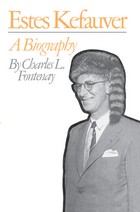2 books about 1903-1963

Estes Kefauver
A Biography
Charles L. Fontenay
University of Tennessee Press, 1980
Reviewed in the United States on December 14, 2009
In the 1950s and early 1960s, Estes Kefauver was everywhere in politics and government. He ran for president twice, was the 1956 Democratic Vice Presidential nominee, pioneered the use of television in Congressional hearings, and dug deep into many policy areas in the US Senate. Most students of politics or government have seen Kefauver's name, but there is surprisingly little comprehensive treatment of him as an individual and not as a part of a broader campaign, Senate history, or legislation. Charles Fortenay spent years trying to correct this vacancy in political biography. Fortenay's effort began during Kefauver's life, but took twenty-five years to get published and not in the form Fontenay had originally imagined.
But the product is a good one. Fontenay takes us from Kefauver's childhood in Tennessee, to his law career, to his service in the US House, to his campaign for the Senate, his pursuit of the presidency in the 1950s, and his legislative battles up to his early death in 1963. In doing so, Fortenay shows us the many paradoxes of Kefauver. Kefauver was a hard working, not particularly charismatic legislator. But he was also a great retail politician, embarrassing Harry Truman and Adlai Stevenson in multiple primaries throughout the 1950s. He was a something of a liberal, but he also looked down at women and was a swing vote on civil rights (To be fair, as a southern senator being a swing vote in civil rights is better than most of his colleagues). Kefauver maintained a close family life despite his active political career, but cheated on his wife fairly openly. Kefauver was ethical and principled (except when it came to monogamy), refusing to cut political deals to win the presidential nomination or keep gifts, but he had a constellation of wealthy friends who paid his personal expenses and bought stock based on the findings of a Congressional investigation.
Any politician, really any person, studied so closely shows some wrinkles. Kefauver is no different. But overall, Kefauver was a hard worker, progressive particularly for his state, and helped democratize the nominating process. In those respects, he is a model for modern senators.
A few nitpicks about the book. First, Fontenay writes that a Congressman Reece died and was replaced by his wife by appointment. Reece's wife won a special election because there are no appointments to fill House vacancies. Second, Fontenay short changes some of Kefauver's policy battles, including presidential succession which is of particular interest to me.
That aside, Fontenay writes a great book. His sources are varied from many personal interviews, to Kefauver's letters, to the biographies of other senators. He manages to balance the many names and personalities and does a particularly good job of explaining the political convention intrigue of the 1950s.
I highly recommend this book to students of politics, government, and history. It fills a void in the literature with the tale of a significant senator of the mid-20th century.
But the product is a good one. Fontenay takes us from Kefauver's childhood in Tennessee, to his law career, to his service in the US House, to his campaign for the Senate, his pursuit of the presidency in the 1950s, and his legislative battles up to his early death in 1963. In doing so, Fortenay shows us the many paradoxes of Kefauver. Kefauver was a hard working, not particularly charismatic legislator. But he was also a great retail politician, embarrassing Harry Truman and Adlai Stevenson in multiple primaries throughout the 1950s. He was a something of a liberal, but he also looked down at women and was a swing vote on civil rights (To be fair, as a southern senator being a swing vote in civil rights is better than most of his colleagues). Kefauver maintained a close family life despite his active political career, but cheated on his wife fairly openly. Kefauver was ethical and principled (except when it came to monogamy), refusing to cut political deals to win the presidential nomination or keep gifts, but he had a constellation of wealthy friends who paid his personal expenses and bought stock based on the findings of a Congressional investigation.
Any politician, really any person, studied so closely shows some wrinkles. Kefauver is no different. But overall, Kefauver was a hard worker, progressive particularly for his state, and helped democratize the nominating process. In those respects, he is a model for modern senators.
A few nitpicks about the book. First, Fontenay writes that a Congressman Reece died and was replaced by his wife by appointment. Reece's wife won a special election because there are no appointments to fill House vacancies. Second, Fontenay short changes some of Kefauver's policy battles, including presidential succession which is of particular interest to me.
That aside, Fontenay writes a great book. His sources are varied from many personal interviews, to Kefauver's letters, to the biographies of other senators. He manages to balance the many names and personalities and does a particularly good job of explaining the political convention intrigue of the 1950s.
I highly recommend this book to students of politics, government, and history. It fills a void in the literature with the tale of a significant senator of the mid-20th century.
[more]

Ozu’s Anti-Cinema
Yoshida Kiju; Translated by Daisuke Miyao & Kyoko Hirano
University of Michigan Press, 2003
Yoshida starts his award-winning Ozu’s Anti-Cinema with a story about his trip to Ozu’s deathbed. Yoshida writes that a dying Ozu whispered to him twice, as if speaking to himself, “Cinema is drama, not accident.” These cryptic last words troubled Yoshida for decades, and throughout this book he examines Ozu’s films and tries to uncover what Ozu really meant.
Ozu’s Anti-Cinema concerns Ozu’s films, but it is also Yoshida’s manifesto on films and filmmaking. In other words, this book is Yoshida’s personal journey into Ozu’s thoughts on filmmaking and, simultaneously, into his own thoughts on the nature of cinema. Every page displays the sensibility of one artist discussing another—this is probably a book that only a filmmaker could write. Within Yoshida’s luminous prose lies a finely tuned, rigorous analysis of Ozu’s films, which have rarely been engaged as closely and personally as here.
[more]
READERS
Browse our collection.
PUBLISHERS
See BiblioVault's publisher services.
STUDENT SERVICES
Files for college accessibility offices.
UChicago Accessibility Resources
home | accessibility | search | about | contact us
BiblioVault ® 2001 - 2024
The University of Chicago Press









